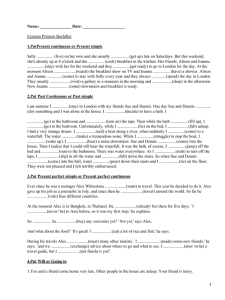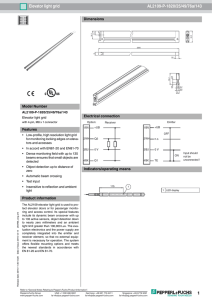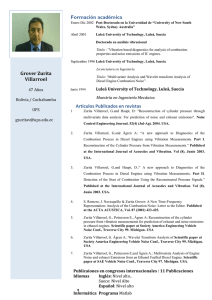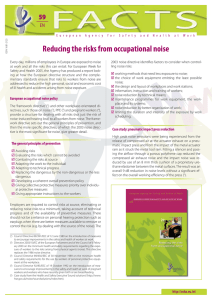Receiver Noise Temperature, the Quantum Noise Limit, and
Anuncio
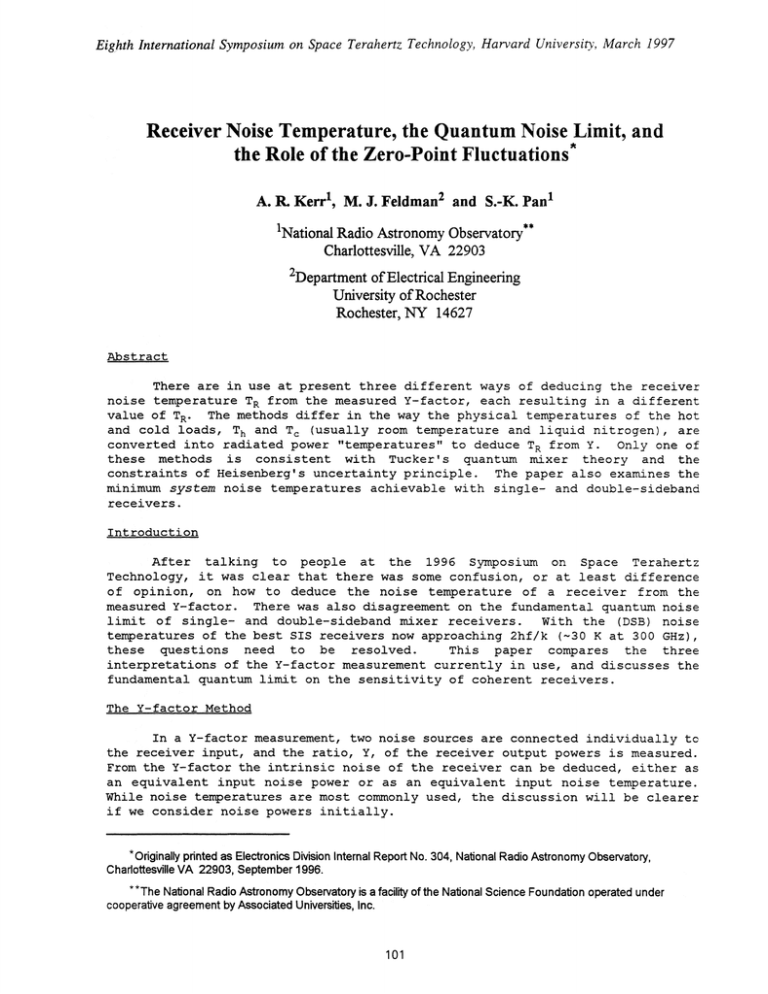
Eighth International Symposium on Space Terahertz Technology, Harvard University, March 1997 Receiver Noise Temperature, the Quantum Noise Limit, and the Role of the Zero-Point Fluctuations* A. R. Kerr', M. J. Feldman 2 and S.-K. Panl 1 National Radio Astronomy Observatory** Charlottesville, VA 22903 2 Department of Electrical Engineering University of Rochester Rochester, NY 14627 Abstract There are in use at present three different ways of deducing the receiver noise temperature T R from the measured Y-factor, each resulting in a different value of T R . The methods differ in the way the physical temperatures of the hot and cold loads, T h and T c (usually room temperature and liquid nitrogen), are converted into radiated power "temperatures" to deduce T R from Y. Only one of these methods is consistent with Tucker's quantum mixer theory and the constraints of Heisenberg's uncertainty principle. The paper also examines the minimum system noise temperatures achievable with single- and double-sideband receivers. Introduction After talking to people at the 1996 Symposium on Space Terahertz Technology, it was clear that there was some confusion, or at least difference of opinion, on how to deduce the noise temperature of a receiver from the measured Y-factor. There was also disagreement on the fundamental quantum noise limit of single- and double-sideband mixer receivers. With the (DSB) noise temperatures of the best SIS receivers now approaching 2hf/k (-30 K at 300 GHz), these questions need to be resolved. This paper compares the three interpretations of the Y-factor measurement currently in use, and discusses the fundamental quantum limit on the sensitivity of coherent receivers. The Y-factor Method In a Y-factor measurement, two noise sources are connected individually to the receiver input, and the ratio, Y, of the receiver output powers is measured. From the Y-factor the intrinsic noise of the receiver can be deduced, either as an equivalent input noise power or as an equivalent input noise temperature. While noise temperatures are most commonly used, the discussion will be clearer if we consider noise powers initially. * Originally printed as Electronics Division Internal Report No. 304, National Radio Astronomy Observatory, Charlottesville VA 22903, September 1996. ** The National Radio Astronomy Observatory is a facility of the National Science Foundation operated under cooperative agreement by Associated Universities, Inc. 101 Eighth International Symposium on Space Terahertz Technology, Harvard University, March 1997 Let P n be the equivalent input noise power of the receiver in a bandwidth B, the measurement bandwidth. B is defined by a bandpass filter at the receiver output (for a coherent receiver (e.g., amplifier or mixer) an input filter is unnecessary) . With a power P in incident on the receiver in bandwidth B, the measured output power of the receiver P mit = G[P n + P 1 ], where G is the gain of the receiver. With hot and cold loads in front of the receiver the measured Yfactor is: pn p Y Pn hot (1) Pcold The equivalent input noise power is found by inverting this equation: pn _ P hot YP cold (2) Y - 1 Frequently the hot and cold loads are simply black-body radiators (well matched waveguide or free-space loads) heated or cooled to accurately known physical temperatures T hot and Tcoid. Power Radiated by a Black Body The Planck radiation law is often used to calculate the thermal noise power in a bandwidth B about frequency f (B << f), radiated into a single mode (e.g., a waveguide mode), by a black body at physical temperature T: p Planck = kTB hf kT (3) hfi exp-. -1 kT where, h and k are the Planck and Boltzmann constants. In the present context, a more complete description is given by the dissipation-fluctuation theorem, or generalized Nyquist theorem, of Callen & Welton NJ: P C&W = kTB hf kT hfi -1 expl. kT hfB 2 (4) hfB coth(i?-_) 2 t 2kT This is simply the Planck formula with an additional half photon per Hz, hfB/2, 1 02 Eighth International Symposium on Space Terahertz Technology, Harvard University, March 1997 and it is this additional half photon, the zero-point fluctuation noise, that is the source of some confusion. Some authors believe that the zero-point fluctuations should be excluded from consideration of noise powers because they do not represent exchangeable power. However, the view of Devyatov et al. [2] is that, although the zero-point fluctuations deliver no real power, the receiver nevertheless "...develops these quantum fluctuations to quite measurable fluctuations..." at its output. The zero-point fluctuations, they argue, should be associated with the incoming radiation and not with the receiver itself: at the receiver input "...one can imagine two zero-point fluctuation waves propagating in opposite directions..." with no net power flow. It is interesting to note [3] that in the limit of small hf/kT, it is the Callen and Welton formula (4) which gives the Rayleigh-Jeans result P = kTB, while the Planck formula (3) gives P = kTB hfB/2, half a photon below the Rayleigh-Jeans result. Noise Temperatures The noise power P n in a bandwidth B is conveniently represented by a noise temperature T n = P n /kB. The noise temperature is simply a shorthand notation for the noise power per unit bandwidth. The noise temperature of a black body radiator at physical temperature T is obtained from the noise power (3, 4) as: T " c w T ' =T hf kT hf exp kT T hf kT hf exp -1 kT hf 2k =•■ hf , u ( hf) CO L.11 2k 2kT (5) • (6) These expressions differ by the zero-point fluctuation noise temperature, hf/2k, whose magnitude is 0.024 K per GHz. In the Rayleigh-Jeans limit of small hf/kT, the noise temperature based on the Callen & Welton formula approaches the physical temperature of the black body ( T c6'/1 -.0 T), while the noise temperature based on the Planck formula is half a photon below the physical temperature ( TPlanck -4 T hf/2k). Fig. 1 shows T n evaluated according to (5) and (6), as functions of the physical temperature T of the black body, for a frequency of 230 GHz. Also shown are the differences between T Planck, TC&W, and TRJ. 1 03 Eighth International Symposium on Space Terahertz Technology, Harvard University, March 1997 20 1 f = 230 GHz 15 = 0 / 10 T(C&W) T(planck) T(R-J) 0 T(C&W) - T(Planck) _____ 5 ..........--- \\ \ T(phys) - T(Planck) __------ - \ ,..--. T(C&W) -------- 1 00 5 - T(phys) - , I 10 15 Physical Temperature K 20 Fig.l. Noise temperature vs physical temperature for black body radiators at 230 GHz, according to the RayleighJeans, Planck, and Callen & Welton laws. Also shown (broken lines) are the differences between the three radiation curves. The Rayleigh-Jeans curve converges to the Callen & Welton curve at high temperature, while the Planck curve is always hf/2k below the Callen & Welton curve. Receiver noise temperature from the Y-factor Equation (2) for the equivalent input noise power of a receiver can be written in terms of noise temperatures using T = P /kB. Thus the equivalent input noise temperature l of the receiver, n n _ hot Tn Tn cold Y- 1 n (7) Three different interpretations of this equation are in use at present. They differ in the values of T;,', and TL id assumed for the hot and cold loads at physical temperatures T hot and T coid . Most often, the Rayleigh-Jeans formula is 1 This definition of receiver noise temperature is now generally accepted in the millimeter and submillimeter receiver community. There are two older definitions of receiver noise temperature which are based on hypothetical measurements rather than on the simple Y-factor measurement (i) The physical temperature of the input termination of a hypothetical noise-free device, which would resutt in the same output noise power as the actual device connected to a noise-free input termination. (ii) The physical temperature of the input termination required to double the output noise of the same receiver with its input termination at absolute zero temperature. Using either of these older definitions causes further complications, beyond the scope of this paper. This question was dealt with at length in [5]. 104 Eighth International Symposium on Space Terahertz Technology, Harvard University, March 1997 used, in which T IL and TL id are equal to the physical temperatures. Some workers use the Planck formula (5), while others use the Callen & Welton formula (6). The three approaches result in three different values of T Rn , which we denote T 11RJ , TRPlanck, and TRC&W: RJ TR — Thot Planck _ TR Tcold Y-1 Planck Y T cold Planck T hot Y- (8) (9) and col Y T cold C&W T CCM _ T hot Y-1 (10) It will become clear in the following sections that only eq.(10) gives a receiver noise temperature consistent with quantum mixer theory [4] and the constraints of the uncertainty principle. For a given value of Y, the difference between the Welton formulas (9, 10) is just half a photon: Planck_ TR T Planck and Callen & hf R 2k This constant half photon difference is independent of the hot and cold load temperatures. The difference between the Rayleigh-Jeans and Callen & Welton formulas (8, 10) depends on the physical temperatures of the hot and cold loads, and on frequency. Fig. 2 shows the receiver noise temperature, calculated according to eqs. (8-10), as a function of Y-factor for a 230 GHz receiver, measured with hot and cold loads at physical temperatures 300 K and 77 K. The small difference between the Rayleigh-Jeans and Callen & Welton results is shown by the dashed curve and referred to the right-hand scale. The negative receiver noise temperatures correspond to physically impossible values of the Y-factor. The physical limits on TR n will be discussed below. The difference between receiver noise temperatures obtained using the Rayleigh-Jeans and Callen & Welton laws is not always as small as in the example in Fig. 2. Only if hf/kT << 1 for the hot and cold loads will T;L7 Z T RC&W . For example, if a 230 GHz receiver were measured using 4 K and room temperature loads, hf/ kT coid = 2.8, and T; 47 is -2.3 K larger than T RC&W . Another example is an 800 GHz receiver measured using 77 K and roam temperature loads; then hf/kT„id = 0.5, and T;"-7 would be -2.0 K larger than TR"w. So far there has been no mention of single- or double-sideband operation. That is because the above discussion applies to both SSB and DSB receivers; a Yfactor measurement on a SSB or DSB receiver gives, via equation (7), the SSB or DSB receiver noise temperature. 105 Eighth International Symposium on Space Terahertz Technology, Harvard University, March 1997 3.20 3.40 3.60 3.80 Y-factor 4.00 4.20 4.40 Fig. 2. Receiver noise temperature as a function of Y-factor for a 230 GHz receiver measured with T hot = 300 K and T = • 7 K The Rayleigh-Jeans curve is obtained when the hot and cold load noise temperatures are equal to their physical temperatures. The Planck and Callen & Welton curves are obtained using equations (5) and(6) for the hot and cold load noise temperatures. The small difference between the Planck and Callen & Welton curves is indicated by the dashed line (right-hand scale). Single- and Double- Sideband Mixer Receivers Mixer receivers can operate in several modes, depending on the configuration of the receiver and the nature of the measurement. In singlesideband operation, the receiver is configured so that, at the image sideband, the mixer is connected to a termination within the receiver. There is no external connection to the image frequency, and the complete receiver is functionally equivalent to an amplifier followed by a frequency converter. In double-sideband operation, on the other hand, the mixer is connected to the same input port at both upper and lower sidebands. A DSB receiver can be used in two modes: (i) to measure narrow-band signals contained entirely within one sideband - this is SSB operation of a DSB receiver. For detection of such narrow-band Signals, power collected in the image band of a DSB receiver degrades the measurement sensitivity. And (ii), to measure broadband (or continuum) sources whose spectrum covers both sidebands - this is DSB operation of a DSB receiver. For continuum radiometry, the additional signal power collected in the image band of a DSB receiver imlaroves the measurement sensitivity. A 7 -'actor measurement on a DSB receiver, interpreted according to eq. (7), gives the so-called DSB receiver noise temperature. This is the most commonly o7ucted noise temperature for mixer receivers because it is easy to measure. It is also common to derive a SSB noise temperature (for a DSB receiver) by measuring the sideband gains, and referring all the receiver noise to a single 106 Eighth International Symposium on Space Terahertz Technology, Harvard University, March 1997 sideband, the signal sideband. Then, for the DSB receiver, T n R , SS13 TR,DSB n 1 G. + G (12) s. where Gs and G i are the receiver gains at the signal and image frequencies2, measured from the hot/cold load input port. If the upper and lower sideband T n 2 gains are equal, R , SSB = TRn,DSB If G i << G s , the Y-factor measurement directly gives TRn, SSB ' When a DSB mixer receiver is used to receive a narrow-band signal contained entirely within one sideband, noise from the image band contributes to the output of the receiver. The overall SSE system noise temperature Pout Tsnys,,SSB kBGs = T sn + T 1 T G. T ( G. 1 TRn, DSB Gs + T Rn SSB , Gs (13) 1 G. + Gs where T: and T i:r1 are the noise temperatures of the signal and image terminations. Fundamental Limits on TR The fundamental limits imposed by the Heisenberg uncertainty principle on the noise of amplifiers, parametric amplifiers, and mixer receivers have been studied by a number of authors over the last thirty five years, and their work is reviewed, with particular attention to mixer receivers, in [5] and [6]. The following general statement can be made: The minimum output noise power of a measurement system using a mixer receiver, SSB or DSB, is hf (i.e. one photon) per unit bandwidth, referred to one sideband at the receiver input. Hence, the minimum system noise temperature is hf/k referred to one sideband at the receiver input — exactly the same result as for a system incorporating an amplifier. The origin of this quantum noise has been much discussed [7, 3, 5, 6], and will be explained with the aid of Figs. 3 and 4, which depict four minimum-noise measurement systems using mixer receivers. Fig. 3 shows two SSB receivers, 3(a) with a short-circuited image, and 3(b) with an image-frequency termination equal to the signal source resistance. For both 3(a) and 3(b), Tucker's quantum mixer theory predicts [4, 5, 8] a minimum receiver noise temperature of hf/2k. In 3(a) the zero-point fluctuations associated with the input termination (at 0 K) contribute half a photon (hf/2k) to the overall system noise temperature, and the mixer contributes the remaining 2 For simplicity, we assume there is no significant conversion of higher harmonic sideband signals present at the input port. If the receiver gain is not negligible at frequencies nf Lo ± n > 1, then additional terms of the form Gn/G, must be added in the parentheses on the right side of eq. (12). 107 Eighth International Symposium on Space Terahertz Technology, Harvard University, March 1997 half photon , which can be shown to originate in the electron shot noise in the mixer. In (b), the zero-point fluctuations associated with the signal source and (internal) image termination each contribute half a photon, which accounts for all the system noise; the mixer itself contributes no noise, which is exactly the result obtained from mixer theory. Here, the down-converted components of the mixer shot noise exactly cancel the IF component, with which they are correlated, a result well known in classical mixer theory. Fig. 4 shows a DSB mixer receiver used in two different measurement modes: 4(a) to measure a signal present only in one sideband (the SSB mode for a DSB receiver), and 4(b) to measure a broadband signal present in both sidebands (the DSB or continuum mode). In 4(a), zero-point fluctuations associated with the input termination (at 0 K) contribute half a photon (hf/2k) in each sideband, and the mixer need contribute no noise, consistent with mixer theory. The same is true in 4(b), in which the presence of the signal in both sidebands doubles the signal power at the output of the system, and the signal-to-noise ratio at the output is twice that of the SSB receivers in Fig. 3. It is this apparent doubling of the receiver gain that leads to the concept of the DSB gain, GD s B = 2G (provided the signal and image gains are equal, i.e., G s = G i = G). It is clear from Figs. 3 and 4 that the minimum receiver noise temperatures for SSE and DSB receivers are, respectively, hf/2k and zero. The minimum system noise temperature, on the other hand, depends on the nature of the particular measurement; for SSB measurements using either SSB or DSB receivers, the minimum system noise temperature is hf/k, while for broadband continuum measurements using a DSB receiver, the minimum (DSB) system noise temperature is hf/2k. From the discussion above, it is clear that in all computations of receiver or system noise temperatures, the zero-point fluctuations associated with resistive terminations at the signal and image frequencies must be included. Equations (4) and (6) must therefore be used in calculating noise powers or temperatures, and the receiver noise temperature must be obtained from the Yfactor according to eq.(10), in which the Callen & Welton law is used for the noise temperature of hot and cold loads. It is appropriate here to address the question of how to compare SSB and DSB receivers: should a DSB receiver be judged against a SSB receiver by comparing their SSE and/or DSB receiver noise temperatures (for the DSB receiver with equal sideband gains, Tar; SS3 = 2 T Rr: DSB ) ? The answer depends on the application. The mode of the measurement (i.e., narrow-band or broadband) must be specified, and in the case of broadband measurements, also the source noise temperature at the signal and image frequencies. This enables the appropriate system noise temperatures to be calculated and compared. When the context is broadband (continuum) radiometry, simply comparing the (SSB) receiver noise temperature of an SSB receiver with the DSB receiver noise temperature of a DSB receiver is appropriate, but when narrow-band (SSB) signals are to be measured no such simple comparison is meaningful. 108 Eighth International Symposium on Space Terahertz Technology, Harvard University, March 1997 SYSTEM RIM MEI 111111 MB MIR MIR MIR MI MIN SSB RECEIVER At T = 0 K S/C MR IMAGE MIXER IF MI RIM OM MIR n Out,min = Source R SIGNAL hf/2k Tn R,min hfj2k C.hf/k • TT n sys,m r, = hf/k Receiver gains G= MIS MIS MI IM MI EMI EMI MRS IM sse RECEIVER WITH SjC IMAGE TERMINATION MINIMUM NOISE TEMPERATURES FOR AN Fig. 3(a) SYSTEM r OMR UMW OMR ORM KM MOM OMR MUM MOM MB OMR MR MIUM OOR ROM WM 1MM OMR MR ROM IMM RM. MO SSB RECEIVER At T = 0 K hf/2k = IMAGE MIXER 4. IF Tn out,min Source R hf/2k I SIGNAL sys,min Tn R,min hf/2k Receiver gains _ G= = G.hf/k = hf/k C, G, = 0 MI MOM MID MB MIS MP 1111.111 IIIII•1 MINI 111011 111111111 WWI _J MINIMUM NOISE TEMPERATURES FOR AN SSB RECEIVER WITH RESISTIVE IMAGE TERMINATION Fig. 3(b) 109 Eighth International Symposium on Space Terahertz Technology, Harvard University, March 1997 SYSTEM Source noise in both sidebar-Ids. Desired signal in one sidebond. DSB RECEIVER At T = 0 K hf/2k I MAGE LO • MIXER IF T"out.min = G.hf/k Source Rs SIGNAL hf/2k T" sys,SSB,min 01.■ n = 0 R,DSB,rnin ?T r' ' R,OSE,min R,ssB,mirT 1 = hf/k Receiver gains G s = G= G DSB = 20 0 1 .1•1 11=1 MN 11111M MI MI MINI NM MI MI UNINI KAINIMUtvl NOISE TEMPERATURES NM FOR A DSB RECEIVER Narrow — Bond (SSB) Measurements Fig. 4(a) SYSTEM MI I= NM MI 11111. II= IMO Source noise in both sidebonds. Desired signal in both sidebonds. l■ =11. =MI IM DSB RECEIVER A-t T = 0 K hf/2k IMAGE MIXER LO SIGNAL hf/2k Source R IF Receiver gains G s = G, = G =fl R,DSF,,r-rin 0 0 , 8 = 20 I. m;t ., : mum NOISE TEMPERATURES FOR A DSB RECEIVER Continuum (DSB) Measurements Fig. 4(b) 110 1 1 1 1 1 1 1 1 1 out.min = G.hf/k T nsys.DSB,min = hf/2k Eighth International Symposium on Space Terahertz Technology, Harvard University, March 1997 Conclusion Tucker's quantum mixer theory predicts a minimum receiver noise temperature of hf/2k for a SSB receiver, and zero for a DSB receiver, results which are consistent with the limitations imposed by the Heisenberg uncertainty principle. With signal (and image) sources at absolute zero temperature, the minimum receiver output noise, referred to the input (and, in the case of a DSB receiver, referred to one sideband) is hf/k, twice the zero-point fluctuation noise. To be consistent with this, the Callen & Welton law (eq.(6)) and not the Planck law (eq.(5)) must be used in deriving the required source noise temperatures. This ensures that the zero-point fluctuation noise associated with the source is included at the input, and in both sidebands in the case of a DSB mixer. For many practical cases, the Rayleigh-Jeansr law is a close approximation to the Callen & Welton law, and eq. (7) with T = T can often be used with insignificant error. When using liquid nitrogen and room temperature blackbodies in measuring the Y-factor, little error is incurred at frequencies up to Use of the Planck law (eq.(5)) for the hot- and cold-load noise - 1 THz. temperatures in deriving receiver noise temperatures from measured Y-factors, is inappropriate, and results in receiver noise temperatures higher by half a photon (hf/2k) than they should be (7.2 K at 300 GHz). In comparing SSB and DSB receivers, the particular application must be considered. When the context is broadband (continuum) radiometry, the (SSE) receiver noise temperature of an SSB receiver can be meaningfully compared with the DSB receiver noise temperature of a DSB receiver, but when narrow-band (SSB) signals are to be measured no such simple comparison is meaningful and the overall system noise temperatures for the intended application must be considered. References [1] H.B. Callen and T.A. Welton, "Irreversibility and generalized noise," Phys. Rev., vol. 83, no. 1, pp. 34-40, July 1951. [2] I. A. Dewatov, L.S. Kuzmin, K. K. Likharev, V. V. Migulin, and A. B. Zorin, "Quantum-statistical theory of microwave detection using superconducting tunnel junctions," J. Appl. Phys., vol. 60, no. 5, pp. 1808-1828, 10 Sept. 1986. [3] M. J. VVengler and D. P. Woody, "Quantum noise in heterodyne detection," IEEE J. of Quantum Electron. vol. QE-23, No. 5, pp. 613-622, May 1987. [4] J.R. Tucker, "Quantum limited detection in tunnel junction mixers," IEEE J. of Quantum Electron. vol. QE-15, no. 11, pp. 1234-1258, Nov. 1979. [5] J.R. Tucker and M.J. Feldman, "Quantum detection at millimeter wavelengths," Rev. Mod. Phys., vol. 57, no. 4, pp. 10551113, Oct 1985. [6] M.J. Feldman, " Quantum noise in the quantum theory of mixing," IEEE Trans. Magnetics, vol. MAG-23, no. 2, pp. 10541057, March 1987. [7] C. M. Caves, "Quantum limits on noise in linear amplifiers," Phys. Rev. D, Third series, vol. 26, no. 8, pp. 1817-1839, 15 October 1982. [8] A. B. Zorin, "Quantum noise in SIS mixers," IEEE Trans. Magnetics, vol. MAG-21, no. 2, pp. 939-942, March 1985. 111
